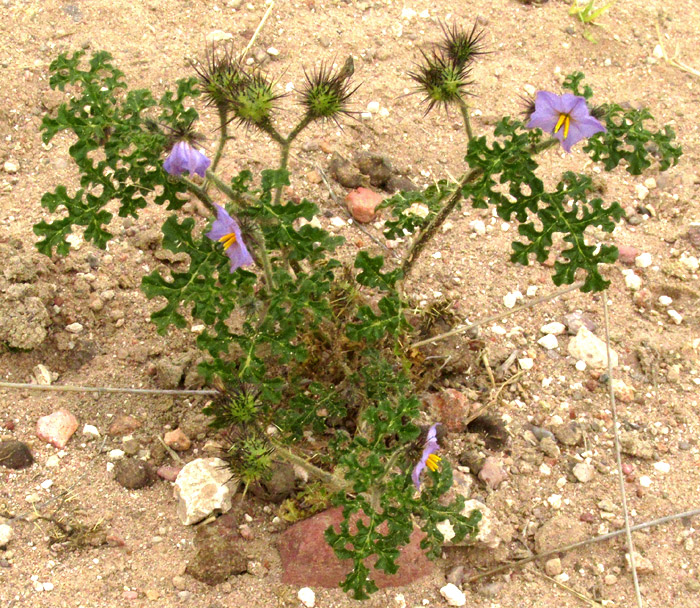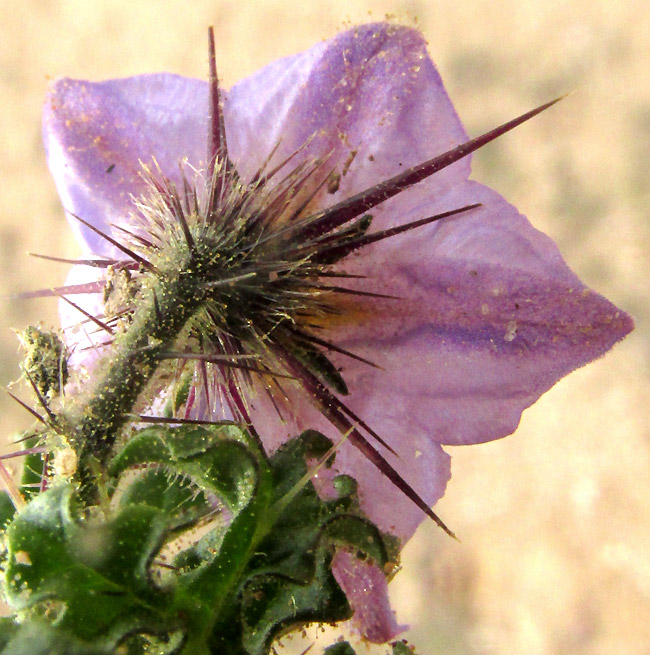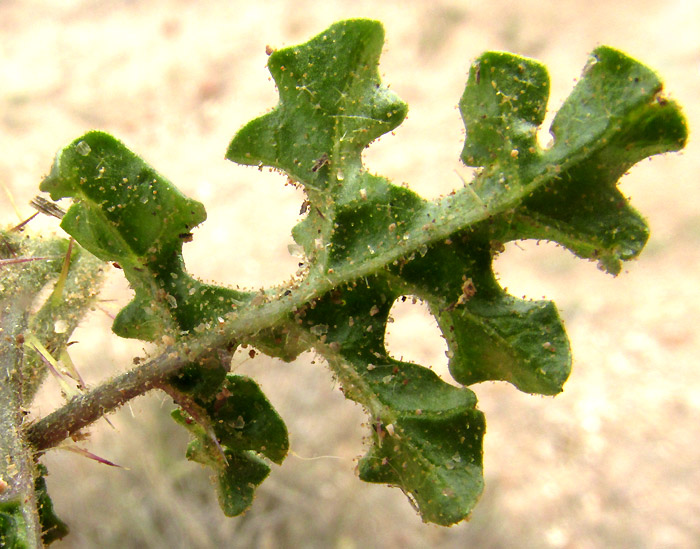Excerpts from Jim Conrad's
Naturalist Newsletter
Entry dated December 25, 2023, issued from near Tequisquiapan; elevation about 1,900m, (6200 ft), ~N20.57°, ~W99.89°; Querétaro state, MÉXICO
MELONLEAF NIGHTSHADE

Seeing the above nightshade species flowering was a real surprise. It grew in hard-compacted dirt along a trail through the scrub so frequented by roving herds of sheep that hardly anything grew there, as suggested by the above plant's barren background. Also, currently we're experiencing a continuing two-year drought described by the online North American Drought Monitor as a D3 Extreme Drought, after a rainy season that simply didn't develop. Any plant able to be green, to flower and fruit -- the spherical, spiny items atop the plant are immature fruits -- under these conditions is very well adapted for exceptionally dry and disturbed soil.

The above configuration of flower parts made clear that this was a nightshade, genus Solanum. The corolla's five-pointed form, along with five conspicuous, banana-shaped anthers dispersing pollen from pores at their tips, not from slits along their sides, was pure Solanum. Also, note that the lowest of the five anthers is longer, broader at its base, dips downward but its tip curves upward, is a feature of numerous Solanum species. The slender, dark style emerging below the anthers and dipping downward, then curving upward, and ending with a greenish stigma about twice as wide as the style's diameter is noteworthy as well. Solanum flowers sometimes are confused with those of the genus Lycianthes, but Lycianthes species aren't spiny, plus their calyxes produce ten sepal-like appendages, as seen on Lycianthes moziniana, not five, as observed on our plant below:

Above, narrow calyx lobes are hard to see below all the spines, but three lobes are at least partially visible. The striking feature of this flower when seen from behind is the size and density of its stiff, sharp spines. Also note that both among the spine bases on the calyx and pedicel, as well as on the leaves, many short hairs are tipped with sticky glands. Once the flowers are pollinated, as the corolla shrivels and dries up, the spiny calyx will enlarge to completely wrap around and protect the otherwise tomato-like fruit. Several very spiny immature fruits appear in our top picture.

Above, a leaf's lower surface bears only a few small spines along the veins but many glandular hairs which gather sand grains and aphid-size insects.
All these features are quite like those of the famous Buffalo Bur, except that that species' corollas are yellow, not violet. In fact, stunted Buffalo Bur plants occasionally appeared on this same trail, while our plant was the only one of its species to be seen.
The 2017 study by Mahinda Martínez and others entitled "Solanaceae family in Mexico," found 130 Solanum species occurring in Mexico. For our highland region of central Mexico, the 2010 digital edition entitled Flora fanerogámica del Valle de México, by Graciela and Jerzy Rzedowski, documents over 25 species. Of those species, on the basis of our herbaceous plant's pinnately compound leaves, its spininess and the corolla's violet corolla, we find ourselves with SOLANUM HETERODOXUM, often called Melonleaf Nightshade.
Solanum heterodoxum lives on silty, sandy or gravelly soils of cultivated and disturbed areas, as well as dunes, streambeds, washes and open slopes from New Mexico southward to about the Mexico City area in central Mexico. Despite its uncommonness in this particular area, in certain disturbed soils it's described as frequent.
Though in general Solanum species are noted for containing powerful compounds often making them toxic or medicinal, I find no traditional human use for Solanum heterodoxum. Probably its spininess accounts for that. In Nature, this species does the usual plant jobs of producing oxygen for us all and maintaining the soil, plus, once the spiny-calyx-enshrouded fruit matures, it opens and dribbles out tiny seeds, which certain creatures probably are glad to eat.
And a human who simply gets a kick from meeting a new Solanum species also recognizes a pleasing "use."